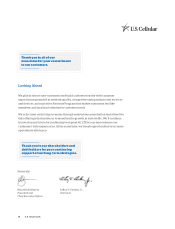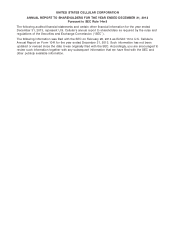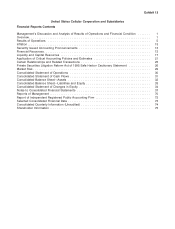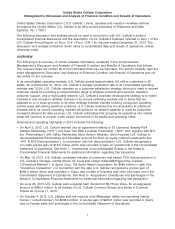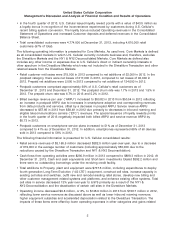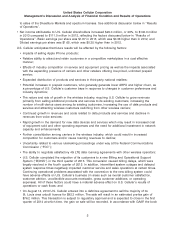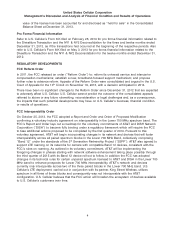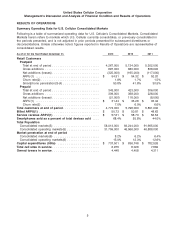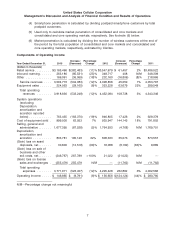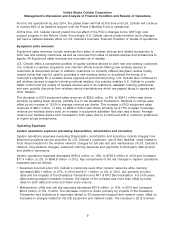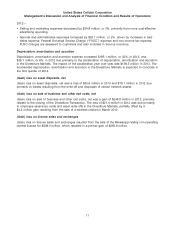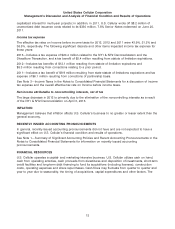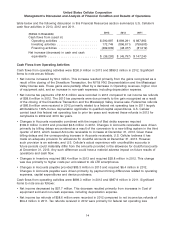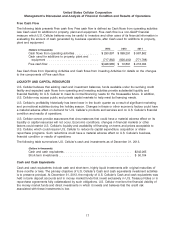US Cellular 2013 Annual Report Download - page 16
Download and view the complete annual report
Please find page 16 of the 2013 US Cellular annual report below. You can navigate through the pages in the report by either clicking on the pages listed below, or by using the keyword search tool below to find specific information within the annual report.United States Cellular Corporation
Management’s Discussion and Analysis of Financial Condition and Results of Operations
Operating Revenues
Service revenues
Service revenues consist primarily of: (i) charges for access, airtime, roaming, recovery of regulatory
costs and value-added services, including data products and services, provided to U.S. Cellular’s retail
customers and to end users through third-party resellers (‘‘retail service’’); (ii) charges to other wireless
carriers whose customers use U.S. Cellular’s wireless systems when roaming, including long-distance
roaming (‘‘inbound roaming’’); and (iii) amounts received from the Federal USF.
Retail service revenues
Retail service revenues decreased by $382.5 million, or 11%, to $3,165.5 million due primarily to a
decrease in U.S. Cellular’s average customer base (including the reductions caused by the Divestiture
Transaction and NY1 & NY2 Deconsolidation) and a slight decrease in billed ARPU. In 2012, retail service
revenues increased by $61.5 million, or 2%, to $3,548.0 million due primarily to the impact of an increase
in billed ARPU, partially offset by a decrease in U.S. Cellular’s average customer base.
In the fourth quarter of 2013, U.S. Cellular issued loyalty reward points with a value of $43.5 million as a
loyalty bonus in recognition of the inconvenience experienced by customers during U.S. Cellular’s recent
billing system conversion. The value of the loyalty bonus reduced Operating revenues in the
Consolidated Statement of Operations and increased Customer deposits and deferred revenues in the
Consolidated Balance Sheet.
Billed ARPU of $50.73 in 2013 was relatively flat compared to $50.81 in 2012. The special issuance of
loyalty rewards points in the fourth quarter of 2013 negatively impacted billed ARPU by $0.70 in 2013,
which was partially offset by an increase in smartphone adoption and corresponding revenues from data
products and services. The increase in billed ARPU in 2012 from $48.63 in 2011 also reflects the impact
of a larger portion of the customer base using smartphones which drives incremental data access
revenue.
U.S. Cellular expects continued pressure on revenues in the foreseeable future due to industry
competition for customers and related effects on pricing of service plan offerings offset to some degree
by continued adoption of smartphones and data usage.
Inbound roaming revenues
Inbound roaming revenues decreased by $85.5 million, or 25% in 2013 to $263.2 million. The decrease
was due primarily to lower rates ($47.9 million) and the impacts of the Divestiture Transaction and NY1 &
NY2 Deconsolidation ($37.6 million). Data volume increased year-over year but the impact of this
increase was offset by the combined impacts of lower volume for voice and lower rates for both data
and voice. The decline in roaming revenues was offset by a decline in roaming expense also due to
lower rates. U.S. Cellular expects continued growth in data volume but also expects that the revenue
impact of this growth will be offset by the impacts of decreases in data rates and voice volume.
Inbound roaming revenues of $348.7 million were flat in 2012 compared to 2011 as higher data
revenues, reflecting significantly higher volumes but lower negotiated rates, were offset by lower voice
revenues, reflecting both lower volumes and rates.
Other revenues
Other revenues decreased by $36.1 million, or 18%, in 2013 compared to 2012. In 2012, Other revenues
decreased by $16.8 million, or 8%. The decreases in both years are due primarily to decreases in ETC
support.
Pursuant to the FCC’s Reform Order (See ‘‘Overview—FCC Reform Order’’), U.S. Cellular’s current ETC
support is being phased down at the rate of 20% per year beginning July 1, 2012. If the Phase II Mobility
8


